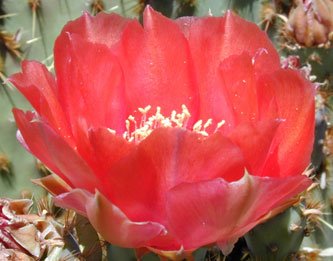



Spring in Apache Junction is just about over and the summer heat is upon us. The season is going out with a glorious bloom of native palo verde trees, probably the best we’ve seen in the six springs we’ve lived in our current home. For most of the year, the native palo verde is a scrubby, spiny, green-barked tree, mostly topping out in the 15-foot range but with some older individuals of certain varieties going to perhaps 30 feet. They started blooming in April and built to a crescendo of yellow waves across the desert around the first of May. On our 1.3 acre property, parts of which had been brutally cleared at one point, there are somewhere around 15 or 20 native palo verde which gives you an idea of the typical density of the trees on residential parcels. On the public lands to the north and south of us, the density is even higher. The bees are so thick in the palo verde that there is a constant humming everywhere in the yard.
The ironwoods are also blooming, although much more subtly with their dusty lavender-rose blooms, and not as exuberantly, with only about half the trees participating. The last couple of years have been a real bust for the ironwoods, so it’s good to see any of them blooming. The two trees we planted the year we moved in are finally showing a bit of color, which is a milestone we’ve been waiting for each year.
The native wildflowers were not as spectacular as we had hoped although the state of Arizona is doing a good job of planting poppies and lupine along newly-constructed sections of highways. In our yard, the penstemon have finally achieved critical mass and are nearing the status of weeds, popping up in the most unlikely places. But the early spring flush is long gone and the yard is preparing to go into desert summer mode. Still there are a few things to enjoy. One of the chollas that I planted in my cactus garden surprised us with dark magenta flowers. The fairy duster has been sporting its bright red tufts for months it seems and the desert milkweed is topped with its own pale yellow flowers, which the butterflies adore. Many of the more-or-less native plants we’ve planted are attractive to the butterflies but have less conspicuous flowers, like the three dalea varieties which are interesting close-up but are not showy from any distance.
This seems to be high season for the lizards. One small one had been living under the brittle bush that I tolerate near the steps at the edge of the patio. After it quits blooming, I regularly prune it way back because its summer version is not particularly attractive. The lizard obviously had a run-in with some predator because it showed up minus its tail one day. Then, a few days ago, I happened to look out the window to see a cactus wren running back and forth through the remaining stems, a very odd behavior. Suddenly the tail-less lizard bolted from the leaf litter and streaked across the patio with the wren in hot pursuit, flying just inches above the flagstone. They had disappeared before I could get to the door to see the outcome. I was feeling a bit down about this until a couple of days later when I saw a lizard with a growing-out tail under the bursage in the wash.
In the meantime, a much larger lizard has moved in and seems to be underfoot every time I pass through the patio area. He had a hole near the pole for the hummingbird feeder into which I saw him disappear completely, at least ten inches including his tail. He must be very limber because no sooner had the tip of his tail vanished than his head reappeared, eyes evaluating the threat of me in my frozen position. Sometimes we will be sitting on the patio and he will start across, then notice us. You can just hear him say, Dang, people, where’d they come from? He’ll freeze, as if scoping out his escape route, then sprint for cover.
The other morning when we were out for a bike ride, a very large lizard crossed the road in right front of us. He was holding his body so high up on surprisingly long legs that at first my brain was confused and thought he was a rodent with a long tail before I realized he was a lizard motating in his own unique fashion.
Labels: spring in AJ


1 Comments:
At 3:40 PM, Jane and John Weichert said…
Jane and John Weichert said…
Enjoyed the description of the desert landscape. It is all so beautiful now. We saw a lizard running across the road just as you described. I wasn't positive what it was as the legs looked so long. Glad to have it confirmed that it was a lizard and not some type of rodent.
Post a Comment
<< Home